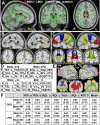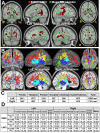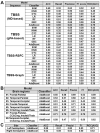Searching for optimal machine learning model to classify mild cognitive impairment (MCI) subtypes using multimodal MRI data
- PMID: 35277565
- PMCID: PMC8917197
- DOI: 10.1038/s41598-022-08231-y
Searching for optimal machine learning model to classify mild cognitive impairment (MCI) subtypes using multimodal MRI data
Abstract
The intervention at the stage of mild cognitive impairment (MCI) is promising for preventing Alzheimer's disease (AD). This study aims to search for the optimal machine learning (ML) model to classify early and late MCI (EMCI and LMCI) subtypes using multimodal MRI data. First, the tract-based spatial statistics (TBSS) analyses showed LMCI-related white matter changes in the Corpus Callosum. The ROI-based tractography addressed the connected cortical areas by affected callosal fibers. We then prepared two feature subsets for ML by measuring resting-state functional connectivity (TBSS-RSFC method) and graph theory metrics (TBSS-Graph method) in these cortical areas, respectively. We also prepared feature subsets of diffusion parameters in the regions of LMCI-related white matter alterations detected by TBSS analyses. Using these feature subsets, we trained and tested multiple ML models for EMCI/LMCI classification with cross-validation. Our results showed the ensemble ML model (AdaBoost) with feature subset of diffusion parameters achieved better performance of mean accuracy 70%. The useful brain regions for classification were those, including frontal, parietal lobe, Corpus Callosum, cingulate regions, insula, and thalamus regions. Our findings indicated the optimal ML model using diffusion parameters might be effective to distinguish LMCI from EMCI subjects at the prodromal stage of AD.
© 2022. The Author(s).
Conflict of interest statement
The authors declare no competing interests.
Figures




Similar articles
-
Comparing different algorithms for the course of Alzheimer's disease using machine learning.Ann Palliat Med. 2021 Sep;10(9):9715-9724. doi: 10.21037/apm-21-2013. Ann Palliat Med. 2021. PMID: 34628897
-
Cortical graph neural network for AD and MCI diagnosis and transfer learning across populations.Neuroimage Clin. 2019;23:101929. doi: 10.1016/j.nicl.2019.101929. Epub 2019 Jul 4. Neuroimage Clin. 2019. PMID: 31491832 Free PMC article.
-
Multimodal magnetic resonance imaging analysis of early mild cognitive impairment.J Alzheimers Dis. 2025 Apr;104(4):1013-1027. doi: 10.1177/13872877251321187. Epub 2025 Mar 3. J Alzheimers Dis. 2025. PMID: 40033775
-
A survey on applications and analysis methods of functional magnetic resonance imaging for Alzheimer's disease.J Neurosci Methods. 2019 Apr 1;317:121-140. doi: 10.1016/j.jneumeth.2018.12.012. Epub 2018 Dec 26. J Neurosci Methods. 2019. PMID: 30593787 Review.
-
Diagnostic power of resting-state fMRI for detection of network connectivity in Alzheimer's disease and mild cognitive impairment: A systematic review.Hum Brain Mapp. 2021 Jun 15;42(9):2941-2968. doi: 10.1002/hbm.25369. Epub 2021 May 4. Hum Brain Mapp. 2021. PMID: 33942449 Free PMC article.
Cited by
-
Identification of Resting-State Network Functional Connectivity and Brain Structural Signatures in Fibromyalgia Using a Machine Learning Approach.Biomedicines. 2022 Nov 22;10(12):3002. doi: 10.3390/biomedicines10123002. Biomedicines. 2022. PMID: 36551758 Free PMC article.
-
Zoom-In Neural Network Deep-Learning Model for Alzheimer's Disease Assessments.Sensors (Basel). 2022 Nov 17;22(22):8887. doi: 10.3390/s22228887. Sensors (Basel). 2022. PMID: 36433486 Free PMC article.
-
A Convolutional Mixer-Based Deep Learning Network for Alzheimer's Disease Classification from Structural Magnetic Resonance Imaging.Diagnostics (Basel). 2025 May 23;15(11):1318. doi: 10.3390/diagnostics15111318. Diagnostics (Basel). 2025. PMID: 40506890 Free PMC article.
-
Classification of Mild Cognitive Impairment and Alzheimer's Disease Using Manual Motor Measures.Neurodegener Dis. 2024;24(2):54-70. doi: 10.1159/000539800. Epub 2024 Jun 12. Neurodegener Dis. 2024. PMID: 38865972 Free PMC article.
-
Frontiers and hotspots evolution in mild cognitive impairment: a bibliometric analysis of from 2013 to 2023.Front Neurosci. 2024 Aug 16;18:1352129. doi: 10.3389/fnins.2024.1352129. eCollection 2024. Front Neurosci. 2024. PMID: 39221008 Free PMC article.
References
-
- Morris JC, et al. Mild cognitive impairment represents early-stage Alzheimer disease. Arch. Neurol. 2001;58:397–405. - PubMed
-
- Alzheimer’s Disease Facts and Figures Alzheimers dement. J. Alzheimers Assoc. 2021;17:327–406. - PubMed
-
- Jessen F, et al. AD dementia risk in late MCI, in early MCI, and in subjective memory impairment. Alzheimers Dement. J. Alzheimers Assoc. 2014;10:76–83. - PubMed
Publication types
MeSH terms
Grants and funding
LinkOut - more resources
Full Text Sources
Medical

